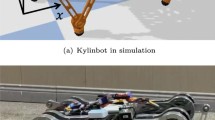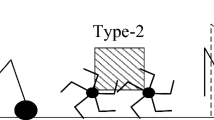Abstract
The study and development of walking robots implies solving several problems related with the design, dynamics, gait patterns, control and other topics inherent to their complex mechanism. One of the most important problems is the trajectory tracking tasks made by the degrees of freedom of each limb. Once the path planner has established the correct trajectory to follow, is necessary to track it with the least possible error. This important task is made by a controller, and helps the robot to maintain a stable walking. In this work we have focused on proposing a GPI control law for a limb of a hexapod walking robot, in order to track smooth trajectories and reject disturbances present in the closed-loop system. We also present the dynamic model of the limb, the designed reference trajectories, control simulations and experimental results.
Similar content being viewed by others
References
T. Hayashi, M. Yamakita, Y. Hanazawa, and F. Asano, “Robust Walking of Biped Robot on Uneven Terrain Using Effect of Wobbling Mass,” Proceedings of the 2014 IEEE International Conference on Robotics and Biomimetics, pp. 2080–2085, Bali, Indonesia, December 2014.
I. Kapustík, J. Hudec and P. Návrat, “Stabilized walking for Nao robot,” IEEE 13th International Symposium on Applied Machine Intelligence and Informatics, pp. 115–118, Herl’any, Slovakia, January 2015. [click]
D. C. Post and J. P. Schmiedeler, “Velocity Disturbance Rejection for Planar Bipeds Walking with HZD–Based Control,” IEEE/RSJ International Conference on Intelligent Robots and Systems, pp. 4882–4887, Chicago, Illinois, September 2014.
P. Manoonpong, S. Dasgupta, D. Goldschmidt, and F. Wörgötter, “Reservoir–based online adaptive forward models with neural control for complex locomotion in a hexapod robot,” International Joint Conference on Neural Networks, pp. 3295–3302, Beijing, China, July 2014. [click]
J. Kumar and R. Tewari, “Quintic polynomial trajectory of biped robot for Human–like walking,” 6th International Symposium on Communications, Control, and Signal Processing, pp. 360–363, Athens, Greece, 2014. [click]
D. Liming, Z. Xianchao, Q. Chenkun, and Gao Feng, “A real–time walking robot control system based on Linux RTAI,” Proceedings of the 2013 International Conference on Advanced Mechatronic Systems, pp. 530–534, Luoyang, China, September 2013. [click]
F. Jian, Y. Xue, and L. Xiang, “Real–time measure and control system of biped walking robot based on sensor,” 10th IEEE International Conference on Control and Automation, pp. 1429–1434, Hangzhou, China, June 2013. [click]
M. Fliess, R. Marquez, E. Delaleau, and H. Sira–Ramírez, “Correcteurs proportionnels–intégraux généralisés,” ESAIM: Control, Optimisation and Calculus of Variations, vol. 7, pp. 23–41, January 2002. [click]
J. A. Juárez–Abad, J. Linares–Flores, E. Guzmán–Ramírez, and H. Sira–Ramírez, “Generalized proportional integral tracking controller for a single–phase multilevel cascade inverter: an FPGA implementation,” IEEE Transactions on Industrial Informatics, vol. 10, no. 1, pp. 256–266, February 2014. [click]
A. Blanco–Ortega, L.G. Vela–Valdés, G. López–López, and A. Magadán–Salazar, “A generalized proportional integral controller for the robust perturbation rejection in an ankle rehabilitation machine,” International Conference on Mechatronics, Electronics and Automotive Engineering, pp. 140–145, Cuernavaca, Mexico, June 2013.
H. Sira–Ramírez and M. A. Oliver–Salazar, “On the robust control of buck–converter. DC–motor combinations,” IEEE Transactions on Power Electronics, vol. 28, no. 8, pp. 3912–3922 August 2013. [click]
H. Sira–Ramírez, F. González–Montáñez, J. Cortés–Romero, and A. Luviano–Juárez, “A disturbance rejection approach for the induction motor through observer based generalized PI control,” American Control Conference, pp. 1162–1167, Montréal Canada, June 2012. [click]
A. Luviano–Juárez, J. Cortés–Romero, and H. Sira–Ramírez, “Chaotic synchronization between oscillators using robust GPI control,” 5th International Conference on Electrical Engineering, Computing Science and Automatic Control, pp. 114–119, Mexico City, Mexico, 2008.
V. M. Hernández and H. Sira–Ramírez, “Generalized proportional integral control of rigid robots,” Proceedings of the 41st IEEE Conference on Decision and Control, Las Vegas, USA, December 2002.
R. Kelly and V. Santibáñez, “Control de movimiento de robots manipuladores,” Pearson Education, 2006.
M. W. Spong, S. Hutchinson, and M. Vidyasagar, Robot Modeling and Control, John Wiley & Sons Inc, 2005.
Author information
Authors and Affiliations
Corresponding author
Additional information
Recommended by Associate Editor Juhoon Back under the direction of Editor Fuchun Sun. This work was supported by Instituto Politécnico Nacional de México, CONACyT de México and Instituto de Investigación y Desarrollo Tecnológico de la Armada de México. The authors would like to thank the Instituto Politécnico Nacional de México, Instituto de Investigación y Desarrollo Tecnológico de la Armada de México, and CONACyT de México for funding this project.
Edwards Sánchez received a Master of Science degree in Electronics Engineering from Escuela Superior de Ingeniería Mecánica y Eléctrica in 2015. His research interests include nonlinear control and visual servoing.
Alberto Luviano was born in Mexico City, Mexico, in 1981. He received his B.S. degree in mechatronics engineering from the Instituto Politécnico Nacional, Mexico, in 2003, an M.Sc. degree in automatic control from the Department of Automatic Control, Centro de Investigación y de Estudios Avanzados (CINVESTAV), Instituto Politécnico Nacional (IPN), in 2006, and a Ph.D. degree in electrical engineering from the Mechatronics section, Departament of Electrical Engineering at CINVESTAV, IPN, in 2011.
Alberto Rosales received his Ph.D. degree in Communications and Electronics (2008), Master of Science in Telecommunications Engineering (2004) and Engineer Communications and Electronics (1999) by ESIME-Instituto Politécnico Nacional de México. Topics currently being developed are: image processing, multispectral and multichannel video in real time, visual computing, as well as medical image processing.
Rights and permissions
About this article
Cite this article
Sánchez, E., Luviano, A. & Rosales, A. A robust GPI controller for trajectory tracking tasks in the limbs of a walking robot. Int. J. Control Autom. Syst. 15, 2786–2795 (2017). https://doi.org/10.1007/s12555-015-0387-2
Received:
Revised:
Accepted:
Published:
Issue Date:
DOI: https://doi.org/10.1007/s12555-015-0387-2




